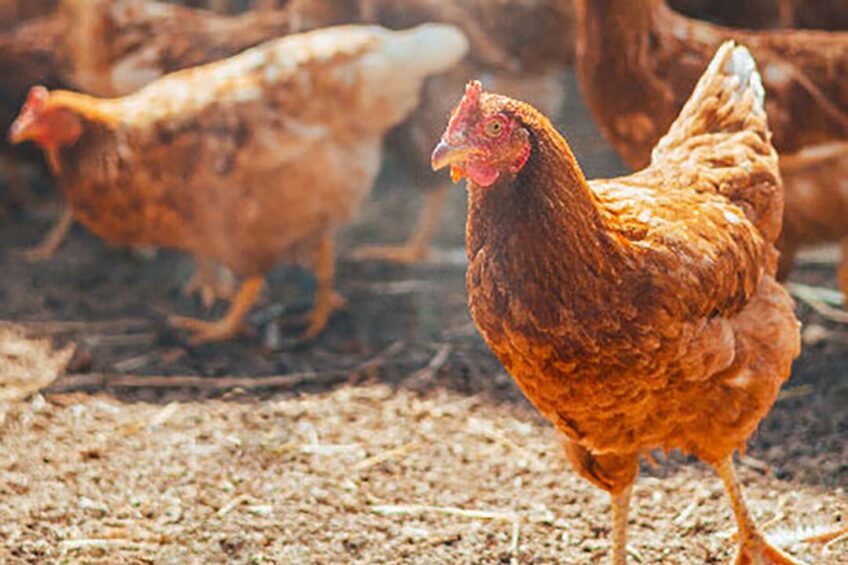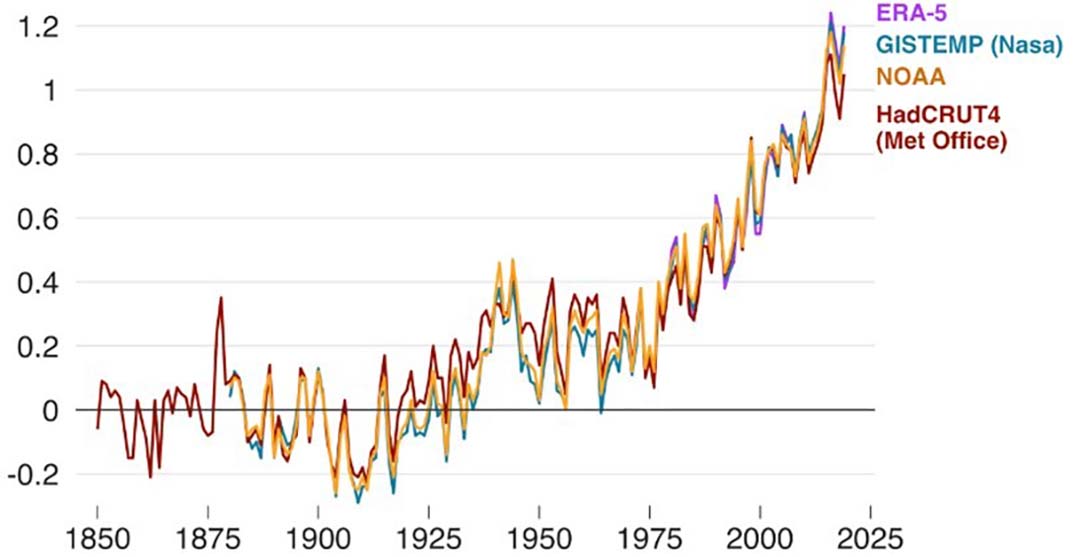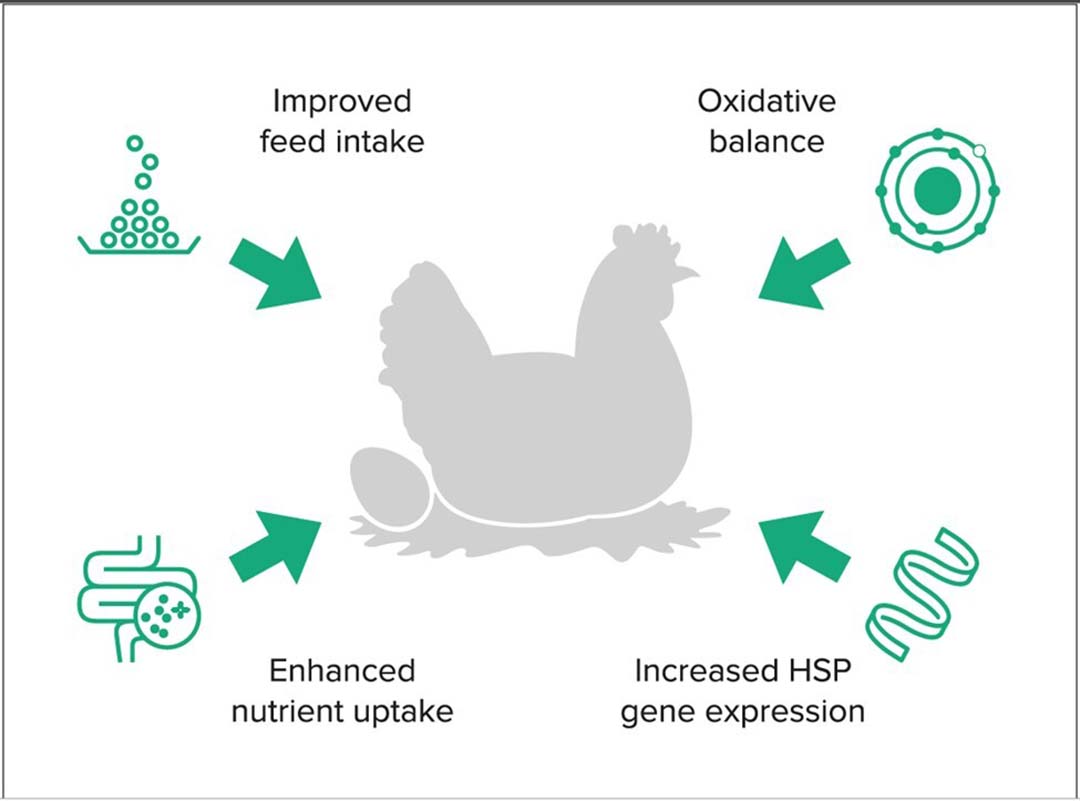Heat stress: Implications of hyperthermia and physiology of layer hens

Recently, there has been a remarkable escalation in global environmental temperature, which poses severe implications for the farming sector in both tropical and subtropical regions.
Climate change increases extreme heat events’ frequency, intensity, and duration (Figure 1). In parallel, genetic modifications for production efficiency have made the modern chicken more vulnerable to environmental stressors. Consequently, the prevalence of physiological heat stress in poultry is also increasing, reducing the ability of birds to be healthy and productive. Heat stress disrupts the physiological processes of hens, which may lead to reduced egg productivity and welfare or even decreased livability, causing unnecessary economic loss.
Figure 1- Temperature change since 1850: global mean temperature change from pre-industrial levels, in °C.

Source: BBC
Effects of heat stress
A layer’s average body temperature is about 40 °C. The optimal performance of laying hens usually occurs when the ambient temperature is between 19 and 22 °C, similar to their thermoneutral zone. Heat stress significantly threatens layers when the temperature rises above 27 °C; when that temperature gets above 32 °C, severe consequences of heat stress might reach the flock since birds lose thermoregulation ability (Figure 2). Besides the temperature itself, air humidity and the ventilation airspeed are critical factors to ensure the ability of birds to deal with uncomfortable thermal conditions.
Figure 2 – Different ambient temperature and physiology status of layer hens.

Physiological effects of heat stress
Although the link between heat stress, health, and animal performance is well established, the biophysical and physiological factors that impact the vulnerability of the individual production unit depend on the duration and degree of thermal exposure and the birds’ health and nutrition status. In most cases, there is a substantial reduction in the feed intake of flocks reared under high temperatures, as heat-stressed birds spend most of the time in acclimatising acclimatising activities such as panting, drinking more water, and resting.
A published scientific paper on laying hens reported a significant decrease in weight gain (Mashaly et al., 2004). The average body weight of a group of hens reared after five weeks of chronic heat stress (at 35 °C) was 300 g (-19%) below a control group produced under optimal temperature conditions. Heat-stressed birds also had worse egg production (-36%), egg mass (-16%), and eggshell quality parameters (up to -30%). The significant decrease in weight and laying performance is possibly due to the strongly reduced feed intake, as birds under heat conditions ate less feed than the control birds. Reduced feed intake and poor nutrient digestibility, common conditions during heat stress, might compromise laying production efficiency and egg quality.
Oxidative stress
Physiological acclimatisation at multiple levels was observed in response to heat exposure. These changes involved indices associated with nutritional depletion, acid-base imbalance, suppressed immune system, and neuroendocrine alterations. Also, high ambient temperature causes oxidative stress by producing reactive oxygen species (ROS), severely affecting birds’ organisms since these free radicals are responsible for lipid peroxidation. Oxidative stress is a significant physiological imbalance that can potentially halt chicken hens’ homeostasis, severely affecting gut functionality, reproductive physiology, and egg quality.
Increased ROS abundance is potentially harmful as it heightens the ageing of organs, causes protein degradation, and damages DNA and RNA, leading to cell apoptosis and tissue injury or malfunction. Like most sources of metabolic stress, high temperature can lead to the hypothalamus’s production and release of ACTH, inducing the production of cortisol. Those stress-related hormones, besides several effects on the behaviour and immunity of birds, downregulate the anti-oxidative enzyme (glutathione peroxidase, superoxide dismutase, heme-oxygenase, etc.) expression produced all over the bird’s body to cope with ROS. This production disturbance might generate a harmful imbalance between free radical liberation and the natural mechanisms to control it. For instance, gut epithelium cells and tight junctions are highly susceptible to ROS action, being easily damaged during oxidative stress, reducing nutrient uptake even more. Similarly, free radicals can significantly injure the reproductive tract epithelium, impairing the formation of egg constituents.
Natural coping mechanisms
Naturally, animals possess some physiological mechanisms to cope with the consequences of heat stress. Among several, the one that has most attracted the attention of researchers is mediated by the so-called Heat Shock Proteins (HSP). All animal species are known to produce different HSPs under the stimuli of high temperatures. Many types of HSPs and a plethora of functions have been associated with them, including protein-folding protection, immune-cell signalising, and tissue reparation. One vital action is to play the role of chaperones to other metabolism-related proteins, enabling them to keep their respective metabolic functions even if the body temperature is not optimal for their synthesis, enzymatic activities, or structural stability. All these functions carried out by HSPs are essential for tissue structural and functional recovery after the stress, enhancing the resilience of birds towards the high-temperature stressor.
Nutritional strategies to cope with HS
Besides all technologies involving laying hens’ houses engineering (roof insulation, ventilation, air humidification, etc.), several nutritional heat-stress-mitigation strategies have been proposed, but their effectiveness varies widely. Dietary supplementation with specific vitamins and minerals (Vitamins A, E, and C; Zn and Se), cationic electrolytes (Sodium bicarbonate or sulfate, Potassium carbonate, etc.), betaine, and the elemental concentration of essential nutrients (such as amino acids and fat) might support farmers with layer flocks facing a heat stress condition, depending on the challenge faced by the birds. Moreover, some feed additives are also recognised to support the livability, appetite, lack of performance, and recovery of heat-stressed layer hens.
Beneficial effects of phytogenic feed solutions
Phytogenic feed solutions have recently gained the recognition of researchers and animal nutritionists as solutions for mitigating various challenges livestock face. These botanical-based compounds can effectively help modify different stages of the animals’ metabolic functions, supporting their health status, resilience capacity, and productive performance through direct and indirect modes of action. Among these modes of action, specifically formulated Phytogenics can be an efficient tool in poultry to tackle the main topics mentioned above in this article: supported feed intake and nutrient utilisation, oxidative balance, and the expression of HSPs.
The first and primary topic is to ensure birds receive enough essential nutrient quantity to live and perform at acceptable levels whenever flocks pass through significantly high-temperature conditions (Figure 3). Phytogenics can help regulate the production of digestive juices and endogenous enzymes, enhancing the degradation of feed components into absorbable nutrients, besides activating nutrient transporter proteins in the cell membrane of the intestinal epithelium. Botanical compounds found in specific bitter substances and essential oils are used to modulate digestive functionality and address these action modes.
Secondly, the metabolic and hormonal stress cascade must be interrupted or even slowed down as much as possible. Certain essential oils help reduce the corticosteroids (mainly cortisol) and catecholamines (epinephrine, norepinephrine, dopamine, etc.) production and release in the blood. This reduction can result in a lower negative impact on appetite when hens are subjected to high temperatures, besides a squeeze on other behaviours that might decrease egg production and quality (e.g., wheezing).
On the metabolic side, reducing catecholamine levels in the blood also supports reduced catabolism of proteins, adipose, and glycogen. Moreover, reducing cortisol is vital to ensure that reproductive regulation hormones (FSH and LH) are released and act during egg formation and laying. Similarly, cortisol reduction is crucial so the expression of antioxidant enzymes can be recovered. In this same direction, the support provided by phytogenics like essential oils and flavonoids helps mitigate oxidative stress impacts through direct (ROS scavenging) and indirect (inducing the expression of antioxidant enzymes) effects, particularly in epithelial tissues of GIT and oviduct.
Finally, recent studies demonstrated the power of some herb extracts in stimulating a higher gene expression toward the synthesis of HSPs, particularly HPS70. This observed effect from substances found in certain plants, such as rosemary, unleashes birds’ intermediary metabolic pathways under high ambient temperatures, helping to support flock livability rates and enhancing hens’ productive performance.
Figure 3 – Beneficial effects of phytogenic feed solutions in mitigating the heat stress challenge in layer hens.

Broader strategy to mitigate the effects of HS
In conclusion, heat stress has become an unavoidable threat to egg-type chicken farmers in sub-tropical and tropical regions. The impairment caused by high temperatures potentially goes way beyond the classical adverse effects on eggshell quality; it might have a massive impact on hens’ welfare, production performance, and economic losses. Farmers must consider multiple tools to build a broad strategy to mitigate this challenging condition, beholding barn engineering, nutritional approaches, and efficient feed products such as phytogenic solutions.








